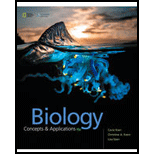
Concept explainers
The type of place where a species typically lives is called its _______.
| a. niche | c. community |
| b. habitat | d. population |
Introduction:
In the biological world, there are different places where a species of an organism lives. These places can be either too far from each other, or too close to each other. There can be some interaction between the components of these places. Different organisms depending upon their needs acquire different benefits from the place where they live.
Answer to Problem 1SA
Correct answer:
A place where a species typically lives is called its habitat. Hence, the correct answer is option b.
Explanation of Solution
Reason for correct answer:
Option b. is given as “habitat.”
A place where a species is typically found is called the habitat of that species. Any species gets the important resources that are necessary for its survival from its habitat only. There are different types of habitat where different species live. Depending on the type of habitat, species adapt themselves to survive.
Reason for incorrect answer:
Option a. is given as, “niche.”
In ecology, a niche refers to the role and the responsibilities that are performed by any species in its environment. It includes the interaction of a species with the biological and non-biological components present in its environment. Hence, option a. is incorrect.
Option c. is given as, “community.”
A community comprises of different populations of different species that are present in same geographical vicinity at the same time. Hence, option c. is incorrect.
Option d. is given as, “population.”
Population refers to the number of individuals that are living together in the same geographical location. The population can be varied for different areas and from time to time. Hence, option d. is incorrect.
Hence, the options a., c., and d. are incorrect.
A habitat is a place where a species typically live in an ecosystem. Thus, the correct option is b.
Want to see more full solutions like this?
Chapter 41 Solutions
BIOLOGY:CONCEPTS+APPL.(LOOSELEAF)
- ____________________________ determine which species can inhabit a place. a. none of the above b. populations c. niches d. habitatsarrow_forwardA feeding relationship that proceeds from algae to a fish, then to a fisherman, and then to a shark is _____. a. a food chain b. a food web c. a and barrow_forwardA researcher investigating how pesticides and water temperature impact the density of phytoplankton in freshwater lakes is primarily focused on ____________ ecology. Group of answer choices A. community B. ecosystem C. biosphere D. population E. organismalarrow_forward
- The function of an organism is its: A. EcosystemB. Population C. Niche D. Habitatarrow_forwardWhy does the aquarium trade contribute to the introduction of nonnative species? a. Exotic species can escape or be released into local ecosystems. b. Aquarium owners do not always understand how ecosystems interact. c. Nonnative fish are shipped worldwide for aquariums. d. All of the above Please select the best answer from the choices provided A B C Darrow_forwardWhich answer best describes the term realized niche? A. All of the resources an organism can consume and all the habitats an organism can occupy. B. The habitat where a species actually lives and the resources it consumes when it is dealing with competition and other interactions in its community.arrow_forward
- What is the difference between a community and an ecosystem? Group of answer choices a. an ecosystem includes the abiotic environment b. a community includes the abiotic environment c. they are exactly the same thing d. an ecosystem covers a larger geographic area e. a community covers a larger geographic areaarrow_forwardIf you are studying the changes in the panda population in Asia you are most likely considered a…. a. Population ecologist b. Ecosystem ecologist c. Global Ecologist d. Community ecologistarrow_forwardThe biggest impacts are made on the environment by: * A. The migration of organisms B. Predation C. Human interference D. Competitionarrow_forward
- A food web: A. Is made by a food spider B. Shows how feeding relationships are interlinked C. Shows the number of organisms in a habitat D. Only shows important animalsarrow_forwardThe process of species replacement over time in a community is called (a) global climate change. (b) succession. (c) competition. (d) community change.arrow_forwardWhen climbing a mountain, we can observe transitions inbiological communities that are analogous to the changes(A) in biomes at different latitudes.(B) in different depths in the ocean.(C) in a community through different seasons.(D) in an ecosystem as it evolves over time.arrow_forward

 Concepts of BiologyBiologyISBN:9781938168116Author:Samantha Fowler, Rebecca Roush, James WisePublisher:OpenStax College
Concepts of BiologyBiologyISBN:9781938168116Author:Samantha Fowler, Rebecca Roush, James WisePublisher:OpenStax College Biology (MindTap Course List)BiologyISBN:9781337392938Author:Eldra Solomon, Charles Martin, Diana W. Martin, Linda R. BergPublisher:Cengage Learning
Biology (MindTap Course List)BiologyISBN:9781337392938Author:Eldra Solomon, Charles Martin, Diana W. Martin, Linda R. BergPublisher:Cengage Learning Human Biology (MindTap Course List)BiologyISBN:9781305112100Author:Cecie Starr, Beverly McMillanPublisher:Cengage Learning
Human Biology (MindTap Course List)BiologyISBN:9781305112100Author:Cecie Starr, Beverly McMillanPublisher:Cengage Learning



